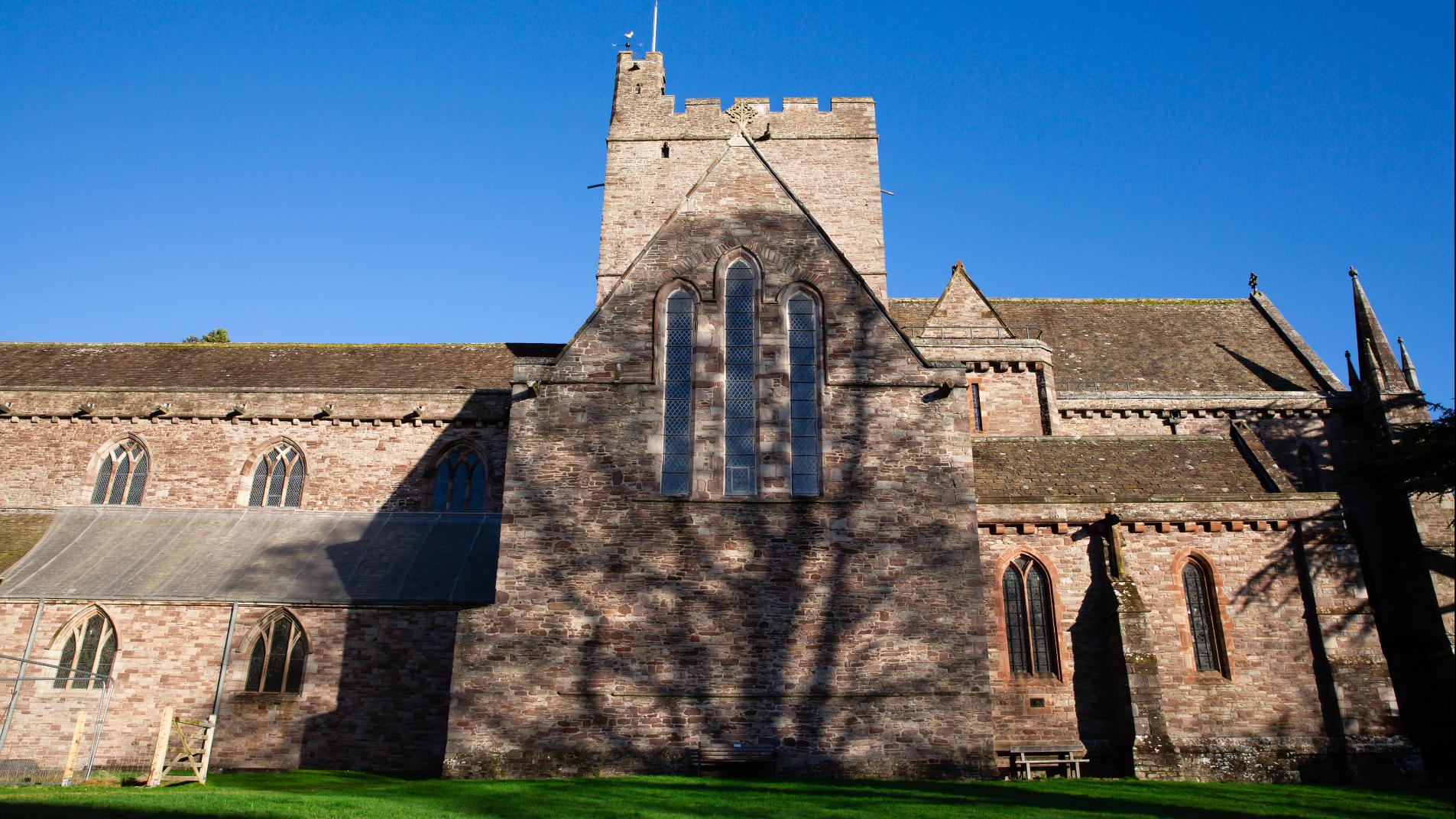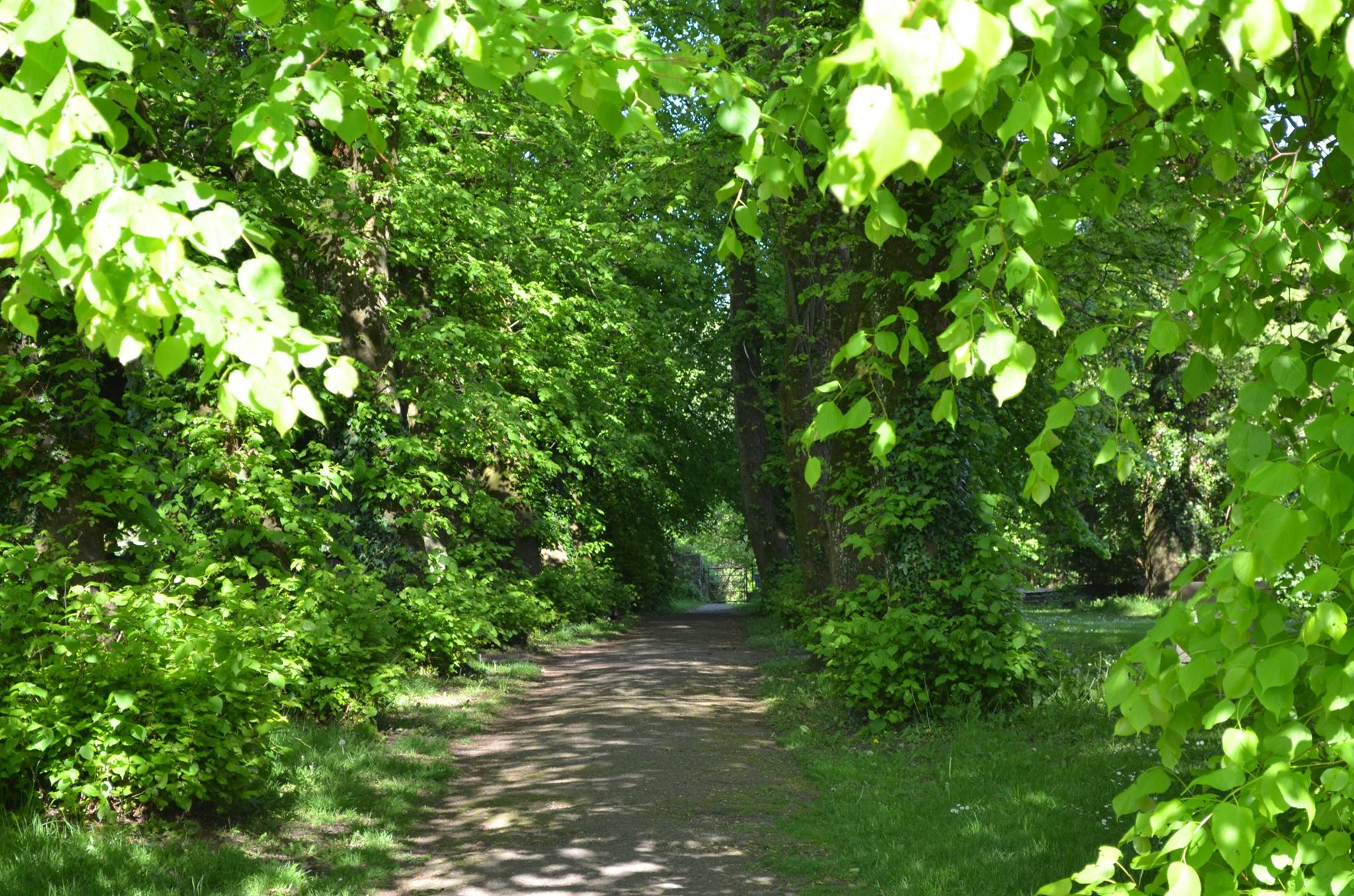
Visit historic buildings at Brecon Cathedral. This is the 6th stop in WALK: The Brecon Story, our heritage trail around Brecon.
Priory Hill and Priory Groves
Crossing the bottom of Priory Hill we come to the Bishop Williamson Garden, a tranquil corner of grass, carrying the name of Edward Williamson, the wartime Bishop of Swansea and Brecon who helped to buy the site in 1939. The garden was opened in his memory in 1968, replacing a succession of woollen mills which had stood here since at least 1521 - and quite possibly for hundreds of years before that (map plaque 18). In the 19th century the mill housed a fifty foot long spinning machine called Billy and was famed for its blankets and flannel shirts. But the machinery could also be dangerous, a 14 year old boy died after his arm was severed while feeding wool into a carding machine in 1916. He had worked at the mill for just four days.
Our journey into Brecon’s manufacturing past continues across the field where the mill’s drying or ‘tendering’ frames once stood and to the start of the Priory Groves. Across the river in the building with the ‘lantern’ top floor was the Brecon Old Brewery. In the 1890s it sold ‘Good Wholesome Harvest Beer’ for eight pence a gallon. Upstream, where the modern houses now stand, Elston’s Modern Garage once traded. Harold Elston was the agent for Ford cars from 1916 (‘runabouts £125’!); American made tractors by 1917 and he set up ‘wireless dances’ within six months of the BBC launching its broadcasting service in 1922. He went on to develop and sell over 3,500 ‘Elstonphone’ wirelesses from June 1923 and even capture some of the earliest television pictures from Crystal Palace in 1931. He also set up a hydro electric scheme on the river - supplying local homes and business before selling up that business in 1936.
Water power was also exploited at the iron furnace on the river Honddu at Forge Farm about a mile north of Brecon and accessed via the Forge Bridge which is signposted from this entry point to the Groves . The furnace built about 1720 and supplied with iron ore and limestone from Hirwaun and charcoal from the surrounding countryside was based on bloom methods. It remained in operation until about 1780, coming under increasing competition from ironworks in the Merthyr area from the middle of the 18th century using coke-fuelled blast furnaces.
From our starting point to Priory Groves, we head up the steep footpath to see, on the right hand side, the original town reservoir. At one point it may have been fed by the now near dry spring coming out of the nearby wall. A parliamentary act of 1776 give powers to set up a new water supply from here, with pipes running into the town. Water from the Honddu was steered here via a leet and a water engine before heading back into town. There was no filtration - so the taps often ran brown when it had been raining!
Brecon Cathedral
We bear left at the reservoir and up to the Cathedral - once called ‘the finest ecclesiastical edifice in Wales’. The curved boundary wall suggests a Celtic, pre-Norman foundation. The Norman conqueror of Brecon, Bernard de Newmarch commissioned a Benedictine Priory here with a church dedicated to St John the Evangelist in 1093. Early records talk about the rebuilding of the church ‘from the foundations’ - further hinting at an existing Welsh church on the site, with new stone coming from quarries in the Priory Groves.
Look below the windows on the east wall of the cathedral and we see the blocked opening of what may be a long lost former crypt. Directly ahead is the Lych Gate that, in living memory, children used to tie up on wedding days in the hope of being thrown coins by the best man. To your right, through the trees and close to the boundry wall you’ll find the grave of Major Charles Lumley, one of the first ever recipients of the Victoria Cross and Legion d’Honeur for services in Crimea where he was badly injured in the head. He was presented with the Victoria Cross by the Queen herself in June 1857 - one of the first ever recipients. He shot and killed himself in Brecon the following year - an inquest blaming ‘temporary insanity’. He was just 34 years old.
Come into the Cathedral itself and have a good look around. The font is 12th century and produced by a group of sculptors, possibly based in Leominster, who shaped many early churches across the borders. Nearby, an ancient stone carries deep gouges, said to have been made by archers as they sharpened their weapons to travel to the Battle of Agincourt against the French in 1415. Another, so called ‘Cresset stone’ is pitted with hollows to hold tallow and wicks to light the building in medieval times. Much of the building is 13th and 14th century but with long periods of decline and much reworking over the generations. The wonderful volunteers who welcome visitors can tell you much more that we can in this short guide. If you are following this tour online, try this virtual tour of the Cathedral’s many historic delights.
Take a virtual tour of the Cathedral
Cathedral Close
Slip back out of the Cathedral via the side door - across from the main entrance - and into the Cathedral Close - the result of church and lay ownership stretching back to medieval times. The area is surrounded by a high stone wall - one 17th century writer saying it was more like a town [wall] than the house of a private Gentleman having no less than Three Great Gates for Entrance.’ To the left is the Tithe Barn, possibly on the site of a ‘new barn for tithe hay’ built for the Priory after 1522. It is mostly 17th century with medieval masonry along the back wall Part of it seemed to have been used for stabling in Georgian times. The overhanging roof at one time sheltered a saw pit with the areas being used as a timber yard.
Opposite the Tithe Barn and hiding behind the hedging is The Almonry - where the Priory would have given out food or ‘alms’ to pilgrims and the poor. It is a medieval building, possibly rebuilt around 1600 with further work in the 18th century - and windows re-worked in 1936.
The Cathedral Close is dominated by The Deanery and Vestries - divided into two by the central tower which may once have acted as a gateway into the former cloisters beyond. These buildings have been in continuous use for 700 years - changing function and appearance over the generations. The Vestries to the left (including the all important Ladies and Gents toilets!) housed a large hall in medieval times, hosting important visitors. Some of them may have stayed upstairs, from where we hear the choir practice today. To the right, the Deanery was called the Tower House. Beyond is Priory House - reminding us that this whole complex of buildings formed part of the medieval Benedictine Priory, acquired on the dissolution of the monasteries by Sir John Price. He published ‘Yny lhyvyr hwnn' or ‘In this book’ - the first book to be printed in the Welsh language in 1546. He was also one of the main promoters of the Acts of Union which brought Wales and England together under the same system of shires. He attended the wedding of Henry VIII to Anne Boelyn. His son, Richard maintained the royal links, attending the courts of King Edward VI, and Queens Mary and Elizabeth. The Price family were said to be on good terms with William Shakespeare and it has been suggested that Shakespeare wrote A Midsommer Night’s Dream here or at another house in the county.
It is at Priory House that Charles I famously stayed on 5 August 1645 after his army was crushed by Cromwell at battle of Naseby. During his stay the King wrote to his son, the future Charles II that he ‘must now prepare for the worst’ and flee to France if he was in danger of capture by parliamentary forces. George IV followed in 1821, staying on his way back from Ireland. He had a meal here prepared by the landlady of the Castle of Brecon Hotel, including the best mutton he had ever eaten. He also sent the cases of four prisoners condemned to death at the local assizes to his Home Secretary for reconsideration. The future Queen Adelaide, wife of William IV ‘partook of a collation’ here on 30 July 1827 and, in our own time, Queen Elizabeth visited the Cathedral and grounds in 1983.
Brecon Cathedral is part of our WALK: The Brecon Story heritage trail. Click here to access the Google Earth map or visit the next place on our trail
